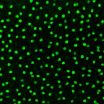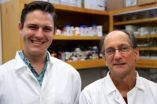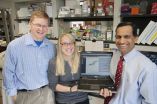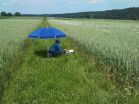(Press-News.org) The functional organization of the central nervous system depends upon a precise architecture and connectivity of distinct types of neurons. Multiple cell types are present within any brain structure, but the rules governing their positioning, and the molecular mechanisms mediating those rules, have been relatively unexplored.
A new study by UC Santa Barbara researchers demonstrates that a particular neuron, the cholinergic amacrine cell, creates a "personal space" in much the same way that people distance themselves from one another in an elevator. In addition, the study, published in the Proceedings of the National Academy of Sciences, shows that this feature is heritable and identifies a genetic contributor to it, pituitary tumor-transforming gene 1 (Pttg1).
Patrick Keeley, a postdoctoral scholar in Benjamin Reese's laboratory at UCSB's Neuroscience Research Institute, has been using the retina as a model system for exploring such principles of developmental neurobiology. The retina is ideal because this portion of the central nervous system lends itself to such spatial analysis.
"Populations of neurons in the retina are laid out in single strata within this layered structure, lending themselves to accurate quantitation and statistical analysis," explained Keeley. "Rather than being distributed as regular lattices of nerve cells, populations in the retina appear to abide by a simple rule, that of minimizing proximity to other cells of the same type. We would like to understand how such populations create and maintain such spacing behavior."
To address this, Keeley and colleagues quantified the regularity in the population of a particular type of amacrine cell in the mouse retina. They did so in 26 genetically distinct strains of mice and found that every strain exhibited this same self-spacing behavior but that some strains did so more efficiently than others. Amacrine cells are retinal interneurons that form connections between other neurons and regulate bipolar cell output.
"The regularity in the patterning of these amacrine cells showed little variation within each strain, while showing conspicuous variation between the strains, indicating a heritable component to this trait," said Keeley.
"This itself was something of a surprise, given that the patterning in such populations has an apparently stochastic quality to it," said Reese, a professor in the Department of Psychological and Brain Sciences. Stochastic systems are random and are analyzed, at least in part, using probability theory.
This strain variation in the regularity of this cellular patterning showed a significant linkage to a location in the genome on chromosome 11, where the researchers identified Pttg1, previously unknown to play any role in the retina.
Working in collaboration with colleagues at the University of Tennessee Health Science Center in Memphis, Keeley's team demonstrated that the expression of this gene varies across the 26 strains of mice and that there was a positive correlation between gene expression and regularity. They then identified a mutation in this gene that itself correlated with expression levels and with regularity. Working with colleagues at Cedars-Sinai Medical Center in Los Angeles, the team also demonstrated directly that this mutation controlled gene expression.
"Pttg1 has diverse functions, being an oncogene for pituitary tumors, and is known to have regulatory functions orchestrating gene expression elsewhere in the body," explained Keeley. "Within this class of retinal neurons, it should be regulating the way in which cells integrate signals from their immediate neighbors, translating that information to position the cell farthest from those neighbors." Future studies should decipher the genetic network controlled by Pttg1 that mediates such nerve-cell spacing.
Keeley, who completed his bachelor of science degree in the Department of Psychological and Brain Sciences, went on to complete his Ph.D. in the Department of Molecular, Cell and Developmental Biology, both at UCSB. Each program has provided complementary training for his research interests. He acquired an appreciation for behavioral and systems neuroscience during his undergraduate training, then turned his attention to the molecular and genetic underpinnings of the nervous system.
INFORMATION:
The social psychology of nerve cells
UCSB researchers explore the genetic underpinnings of nerve-cell spacing
2014-06-26
ELSE PRESS RELEASES FROM THIS DATE:
US should re-evaluate definition of skilled workers in immigration policy
2014-06-26
New immigration research from Rice University, the University of North Carolina and the Centre for Population, Poverty and Public Policy Studies suggests the U.S. should re-evaluate its definition of skilled workers to include informal skills of migrant workers.
The study, "Identifying and Measuring the Lifelong Human Capital of 'Unskilled' Migrants in the Mexico-U.S. Migrator Circuit," draws on a binational multistage research project that involved interviews with 320 Mexican migrants and return migrants in North Carolina and Guanajuato, Mexico. The study identifies ...
Researchers home in on way to predict aggressiveness of oral cancer
2014-06-26
Studying mouth cancer in mice, researchers have found a way to predict the aggressiveness of similar tumors in people, an early step toward a diagnostic test that could guide treatment, according to researchers at Washington University School of Medicine in St. Louis.
"All patients with advanced head and neck cancer get similar treatments," said Ravindra Uppaluri, MD, PhD, associate professor of otolaryngology. "We have patients who do well on standard combinations of surgery, radiation and chemotherapy, and patients who don't do so well. We're interested in finding out ...
Over-activity of enzyme HDAC6 exacerbates symptoms of Amyotrophic Lateral Sclerosis
2014-06-26
Scientists at VIB and KU Leuven have demonstrated in fruit-flies that over-activity of the enzyme HDAC6 in the nerve ends exacerbates the symptoms of the neurodegenerative condition Amyotrophic Lateral Sclerosis (ALS / Lou Gehrig's Disease). Inhibition of this enzyme could offer a protective effect against ALS.
Patrik Verstreken (VIB/KU Leuven): "Nobody wants to suffer from a degenerative condition such as amyotrophic lateral sclerosis (ALS), in which you lose coordination of all muscles through gradual damage to the nerve cells. ALS patients are conscious throughout ...
Organic agriculture boosts biodiversity on farmlands
2014-06-26
Organic farming fosters biodiversity. At least that's the theory. In practice, however, the number of habitats on the land plays an important role alongside the type and intensity of farming practices. These are the findings of an international study that looked at 10 regions in Europe and two in Africa. The results has been published in Nature Communications. The study shows that even organic farms have to actively support biodiversity by, for example, conserving different habitats on their holdings.
An international team, including participants from Technische Universität ...
We speak as we feel -- we feel as we speak
2014-06-26
A team of researchers headed by the Erfurt-based psychologist Prof. Ralf Rummer and the Cologne-based phoneticist Prof. Martine Grice has carried out some ground-breaking experiments to uncover the links between language and emotions. They were able to demonstrate that the articulation of vowels systematically influences our feelings and vice versa.
The research project looked at the question of whether and to what extent the meaning of words is linked to their sound. The specific focus of the project was on two special cases; the sound of the long 'i' vowel (/i:/) and ...
Rosin up that bow, maestro. And thank your genes
2014-06-26
EAST LANSING, Mich. --- Mom or dad may have driven you to cello rehearsal all those years, but you can also thank your genes for pushing you to practice, according to new research led by a Michigan State University professor.
Genetics and environment work together to help people become accomplished musicians, finds the study of 850 sets of twins. It's another arrow in the quiver of the argument that both nature and nurture play a role in developing expertise.
"The nature vs. nurture debate has raged since the beginning of psychology," said Zach Hambrick, MSU professor ...
Packing hundreds of sensors into a single optical fiber for use in harsh environments
2014-06-26
WASHINGTON, June 26, 2014—By fusing together the concepts of active fiber sensors and high-temperature fiber sensors, a team of researchers at the University of Pittsburgh has created an all-optical high-temperature sensor for gas flow measurements that operates at record-setting temperatures above 800 degrees Celsius.
This technology is expected to find industrial sensing applications in harsh environments ranging from deep geothermal drill cores to the interiors of nuclear reactors to the cold vacuum of space missions, and it may eventually be extended to many others.
The ...
NNI releases progress review on environmental, health, & safety research
2014-06-26
The National Nanotechnology Initiative (NNI) released today a Progress Review on the Coordinated Implementation of the National Nanotechnology Initiative 2011 Environmental, Health, and Safety Research Strategy, a document that demonstrates the wide range of research activities, accomplishments, and collaborations of Federal agencies working toward the responsible development of nanotechnology.
This document is a result of efforts by the Federal agencies participating in the Nanotechnology Environmental and Health Implications (NEHI) Working Group. NEHI is a Working Group ...
Capturing CO2 emissions needed to meet climate targets
2014-06-26
This is shown by the most comprehensive study to date on technology strategies to combat climate change, published in a special issue of the journal Climatic Change. It is based on the analysis of 18 computer models by an international team of scientists under the roof of the Stanford Energy Modelling Forum (EMF 27).
"Versatile technologies seem to be most important to keep costs in check," says lead author Elmar Kriegler from the Potsdam Institute for Climate Impact Research. Both bioenergy and CCS can help reduce emissions from non-electric energy use that would be ...
Does psychostimulant use increase cardiovascular risk in children with ADHD?
2014-06-26
New Rochelle, NY, June 26, 2014—Psychostimulant use to treat children and adolescents with attention-deficit/hyperactivity disorder (ADHD) is increasing worldwide, and the evaluation of the cardiovascular safety of stimulant medication used in treatment has been a recent topic of concern. The results of the first nationwide study of the cardiovascular safety of stimulants in children and adolescents are published in Journal of Child and Adolescent Psychopharmacology (JCAP), a peer-reviewed journal from Mary Ann Liebert, Inc., publishers. The article is available free on ...
LAST 30 PRESS RELEASES:
Fertility remains high in rural Tanzania despite access to family planning
AI-assisted device can improve autism care access
Kinetic careers
Uncovering how parasitic plants avoid attacking themselves to improve crop resistance
Nanoparticle vaccine strategy could protect against Ebola and other deadly filoviruses
Study finds brain care score can predict risk of stroke across racial groups
Key lung immune cells can intensify allergic reactions
Do hormones explain why women experience more gut pain?
New materials conduct ions in solids as easily as in liquids
Breakthrough of the Year: Renewable energy begins to eclipse fossil fuel-based sources
LLM use is reshaping scientific enterprise by increasing output, reducing quality and more
Introducing LightGen, a chip for ultra-fast, ultra-efficient generative AI
Astronomers see fireworks from violent collisions around nearby star
ACC/AHA issue new guideline on managing congenital heart disease in adults
Cosmic crash caught on camera
Is talented youth nurtured the wrong way? New study shows: top performers develop differently than assumed
Ants: An untapped resource in the development of antibiotics?
Archaeologists use AI to create prehistoric video game
Mitochondria migrate toward the cell membrane in response to high glucose levels
Tiny viral switch offers hope against drug-resistant bacteria
Most parents aware of early peanut introduction guidelines, but confused about details
HPV vaccine can protect against severe lesions of the vulva and vagina
Virtual care provision and emergency department use among children and youth
Quadrivalent HPV vaccine and high-grade vulvovaginal lesions
Insights into dry eyes gained from stem cell-derived tear glands
Researchers identify 166 human pluripotent stem cell lines available for use in clinical applications
Europa Clipper instrument uniquely observed interstellar comet 3I/ATLAS
UN University Report challenges climate change as sole trigger of Syrian Civil War, exposing governance failures in drought response
Real estate investment trust (REIT) acquisition associated with hospital closure and bankruptcy
New Raman imaging system detects subtle tumor signals
[Press-News.org] The social psychology of nerve cellsUCSB researchers explore the genetic underpinnings of nerve-cell spacing






